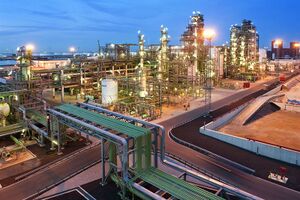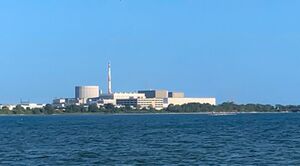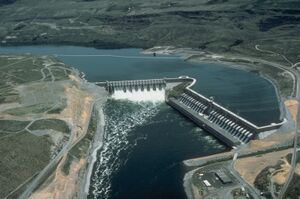Energy production in Arvor: Difference between revisions
m (Add category) |
m (→Biodiesel) |
||
| Line 13: | Line 13: | ||
Biodiesel is distributed from the point of production to terminals and wholesalers by truck or train. B5 is sometimes shipped by pipeline. Most biodiesel distributors will deliver B20 or B100 depending on the retailer's preference. | Biodiesel is distributed from the point of production to terminals and wholesalers by truck or train. B5 is sometimes shipped by pipeline. Most biodiesel distributors will deliver B20 or B100 depending on the retailer's preference. | ||
As of 1.1.7689 RH, [[State enterprises of Arvor|GP Biodizprom]] is the world's largest producer of biodiesel | As of 1.1.7689 RH, [[State enterprises of Arvor|GP Biodizprom]] is the world's largest producer of biodiesel. As of the same year, a litre of biodiesel costs ₽3. A typical automobile can go 19.11 kilometres (11.88 miles) per litre of fuel. | ||
Latest revision as of 02:58, 16 November 2024
Energy production in Arvor comes from four primary sources: biodiesel, nuclear, hydropower, and solar.
In 7689 RH, the ADR was the largest producer and consumer of energy in D'Runia. The nation's power network, known as the National Grid (Gosvlast), provides power throughout the country via a mix of nuclear, hydro, solar, and biofuels. Of those, the largest portion (68%) of the nation's energy is provided by nuclear generating stations. Every two years, one-quarter of the fuel assemblies within reactors are replaced, and the spent fuel sent for recycling and reuse.
Gosvlast is maintained and operated by the Ministry of Energy. Extensive safeguards and precautionary measures are sustained to ensure the grid and its functionality are protected.
Biodiesel

Biodiesel is the primary stored fuel source in the ADR. It is produced from vegetable oils, yellow grease, used cooking oils, and animal fats. These are collected from food production firms, restaurants, and farms. The fuel is produced by transesterification — a process that converts fats and oils into biodiesel and glycerin (a coproduct). Approximately 45.359 kilograms (100 pounds) of oil or fat are reacted with 4.535 kilograms (10 pounds) of a short-chain alcohol (usually methanol) in the presence of a catalyst (usually sodium hydroxide [NaOH] or potassium hydroxide [KOH]) to form 45.359 kilograms of biodiesel and 4.535 kilograms of glycerin (or glycerol). Glycerin, the coproduct produced in the same process, is a sugar commonly used in the manufacture of pharmaceuticals and cosmetics. A dry wash process is used in removing contaminants from the fuel and serves to reduce water consumption.
Biodiesel is distributed from the point of production to terminals and wholesalers by truck or train. B5 is sometimes shipped by pipeline. Most biodiesel distributors will deliver B20 or B100 depending on the retailer's preference.
As of 1.1.7689 RH, GP Biodizprom is the world's largest producer of biodiesel. As of the same year, a litre of biodiesel costs ₽3. A typical automobile can go 19.11 kilometres (11.88 miles) per litre of fuel.
Nuclear

Thanks to sizable vesium resources, Arvor has a robust nuclear power industry, and is a world leader in the technology. Initially spurred on by the development of nuclear weapons, further studies conducted by TsINK-YNT of the Central Institutes of Science and Technology demonstrated the feasibility of civilian nuclear power, which led to the construction of the world's first atomic power station, Ryarmansk Generating Station, in 7673 RH. It has since been decommissioned and replaced by a newer, more modern facility known as Ryarmansk-2.
Approximately 81% of all electricity generated by Gosvlast is produced via nuclear reactors. A regular programme of fuel replacement is maintained, and fuel assemblies removed from reactors are sent for recycling, which allows them to be reused in reactors in the future. In this way, the volume of highly radioactive waste is reduced by 5 and the long-term radiotoxicity by 10. All nuclear generating stations maintain an active interconnection enabling them to keep track of and report any unusual radiation signatures through a network of localised atmospheric sensors, and stringent security protocols keep the facilities safe from potential physical dangers. Multiple layers of redundant and complimentary safety systems likewise ensure the risks of radiation release are minimal.
Since the first reactor at Ryarmansk went online in 7673, Gosvlast has maintained its record of zero reactor accidents (defined as the uncontrolled release of fission products to the environment resulting from damage to a reactor core).
Hydro

Gosvlast produces 11% of the nation's power via hydroelectric generation. The majority of these facilities are located in the northeast and northwest of the nation, where several isolated mountain valleys have been transformed into reservoirs. These facilities are strictly maintained and meticulously serviced on a regular basis, enabling the production of clean, plentiful energy. The turbines of the nation's hydro facilities are produced by SK GIDROMASH and provided for both domestic and foreign use. Among the largest hydro generating stations in the nation is Kurzhinsk Dam, in Dolgoye Oblast in the Suyana Mountains of northeastern Arvor (pictured), equipped with 27 Yeremeyev turbines capable of producing over 2,600 MW.
Solar
Solar generating stations produce 8% of the nation's power. The configuration used throughout the republic, known as the Sunflower (Подсолнух), was developed jointly between SK GIDROMASH and TsINK-EEI of the Central Institutes of Science and Technology. Many solar stations are situated in coastal areas or on slightly higher elevations and situated so that the panels can be adjusted to follow the movement of the sun. The nameplate capacity of Sunflower photovoltaic power stations is rated in megawatt-peak (MWp), referring to the theoretical maximum DC power output.